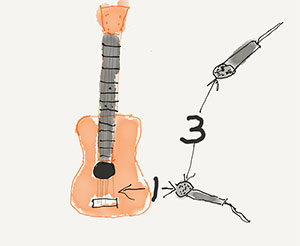 The 3:1 rule is oft-quoted, but it’s also a bit misunderstood. The rule is based upon the use of multiple microphones recording multiple (usually) instruments, and recording everything at the same time. There is quite a lot of misinformation about the 3:1 rule.
The 3:1 rule is oft-quoted, but it’s also a bit misunderstood. The rule is based upon the use of multiple microphones recording multiple (usually) instruments, and recording everything at the same time. There is quite a lot of misinformation about the 3:1 rule.
When you record with 2 or more microphones at the same time – especially if the microphones are not recording to separate tracks – you run a risk of the signals from the multiple mics not playing well with the other(s).
The whole reason for the 3:1 rule is to make sure the waveforms of multiple microphones don’t fight each other in the mix. When you use multiple mics, the signals bleed into all the mics and can cause what’s called “phase” problems where waves simultaneously cancel each other out or make certain frequencies louder. This creates a hollow, unpleasant sound (called “comb-filtering”). So proper spacing of mics via the 3:1 rule can help prevent this phasing in the mix.
Most folks recording at home these days record one thing at a time with usually only one mic on each thing. If you’re doing that (I do it like this mainly because I record everything myself:)), recording one thing at a time, the rule doesn’t come into play.
It also does not come into play when recording a single instrument in stereo – using 2 mics on one guitar, for example. This is a COMMON MISCONCEPTION.
What is the 3:1 Rule then?
This rule simply states that distance matters – the proper spacing from the instruments to your microphone or microphones. The distance between, say, mic A and mic B (if using 2 mics) should be at least 3 times the distance from mic A and the source (guitar, drums, etc.).
Find out more here: http://en.audiofanzine.com/recording-mixing/editorial/articles/the-3-1-rule.html
Leave a Reply